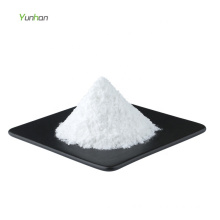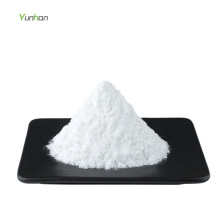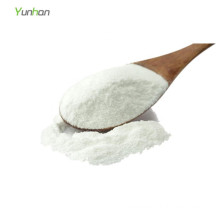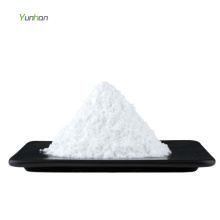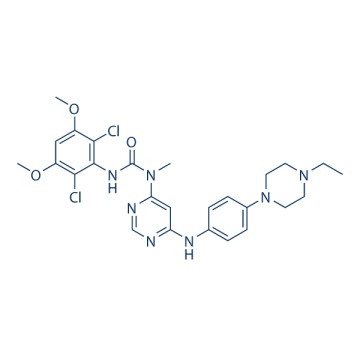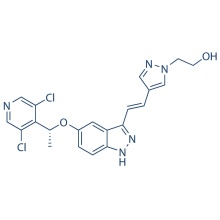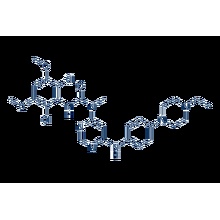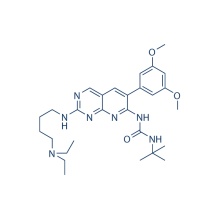BGJ398 (NVP-BGJ398) 872511-34-7
Product Description
.cp_wz table {border-top: 1px solid #ccc;border-left:1px solid #ccc; } .cp_wz table td{border-right: 1px solid #ccc; border-bottom: 1px solid #ccc; padding: 5px 0px 0px 5px;} .cp_wz table th {border-right: 1px solid #ccc;border-bottom: 1px solid #ccc; padding: 5px 0px 0px 5px;}
Molecular Weight:
560.48 BGJ398 (NVP-BGJ398) is a potent and selective FGFR Inhibitor for FGFR1/2/3 with IC50 of 0.9 nM/1.4 nM/1 nM, >40-fold selective for FGFR versus FGFR4 and VEGFR2, and little activity to Abl, Fyn, Kit, Lck, Lyn and Yes. Phase 2.
Biological Activity
BGJ398 also prevents VEGFR2 with low potency. The IC50 of BGJ398 for
inhibiting VEGFR2 is 0.18 μM. BGJ398 suppresses other kinases including
ABL, FYN, KIT, LCK, LYN and YES with IC50 of 2.3 μM, 1.9 μM, 0.75 μM,
2.5 μM, 0.3 μM and 1.1 μM, respectively. At the cellular level, BGJ398
inhibits the proliferation of the FGFR1-, FGFR2-Q, and FGFR3-dependent
BaF3 cells with IC50 of 2.9 μM, 2.0 μM and 2 μM, respectively.
BGJ398
interferes with autophosphorylation on specific tyrosine residues
including FGFR-WT, FGFR2-WT, FGFR3-K650E, FGFR3-S249C and FGFR4-WT with
IC50 of 4.6 nM, 4.9 nM, 5 nM, 5 nM and 168 nM, respectively. BGJ398
suppresses proliferation of the cancer cells with wild-type (WT) FGFR3
overexpression such as RT112, RT4, SW780 and JMSU1 with IC50 of 5 nM, 30
nM, 32 nM and 15 nM, respectively.
In this orthotopic xenograft bladder cancer model, BGJ398 induces tumor
growth inhibition and stasis after oral administration for 12
consecutive days at the doses of 10 and 30 mg/kg, respectively.
Interestingly, the animals that received BGJ398 exhibits either no body
weight loss (10 mg/kg) or 10% body weight gain (30 mg/kg), a further
indication of efficacy.
RT112 tumor-bearing and female Rowett rats
receive a single oral administration of the monophosphate salt of BGJ398
at the doses of 4.25 and 8.51 mg/kg. BGJ398 significantly decreases the
levels of pFRS2 and pMAPK in a dose-dependent manner. BGJ398 inhibits
significantly bFGF-stimulated Angiogenesis in a dose-dependent manner.
However, BGJ398 does not impair VEGF-induced blood vessel formation.
Radiometric kinase assay
The enzymatic kinase activity is assessed by measuring the
phosphorylation of a synthetic substrate by the purified GST-fusion
FGFR3-K650E kinase domain, in the presence of radiolabeled ATP. Enzyme
activities are measured by mixing 10 μL of a 3-fold concentrated BGJ398
solution or control with 10 μL of the corresponding substrate mixture
(peptidic substrate, ATP and [γ33P]ATP).
The reactions are
initiated by addition of 10 μL of a 3-fold concentrated solution of the
enzyme in assay buffer. The final concentrations of the assay components
are as following: 10 ng of GST-FGFR3-K650E, 20 mM Tris-HCl, pH 7.5, 3
mM MnCl2, 3 mM MgCl2, 1 mM DTT, 250 μg/mL PEG 20000, 2 μg/mL poly(EY) 4:1, 1% DMSO and 0.5 μM ATP (γ-[33P]-ATP
0.1 μCi).
The assay is carried out according to the filter binding (FB)
method in 96-well plates at room temperature for 10 minutes in a final
volume of 30 μL including BGJ398. The enzymatic reactions are stopped by
the addition of 20 μL of 125 mM EDTA, and the incorporation of 33P
into the polypeptidic substrates is quantified as following: 30 μL of
the stopped reaction mixture are transferred onto Immobilon-PVDF
membranes previously soaked for 5 minutes with methanol, rinsed with
water, soaked for 5 min with 0.5% H3PO4, and
mounted on vacuum manifold with disconnected vacuum source. After
spotting, vacuum is connected, and each well rinsed with 0.5% H3PO4 (200 μL).
Free membranes are removed and ished four times on a shaker with 1% H3PO4 and once with ethanol. Membranes are dried and overlaid with addition
of 10 μL/well of a scintillation fluid. The plates are eventually sealed
and counted in a microplate scintillation counter. IC50 values are
calculated by linear regression analysis of the percentage inhibition of
the BGJ398.
Method
Murine BaF3 cell lines, whose proliferation and survival has been
rendered IL-3-independent by stable transduction with tyrosine kinases
activated either by mutation or fusion with a dimerizing partner, are
cultured in RPMI-1640 media supplemented with 10% FBS, 4.5 g/L glucose,
1.5 g/L sodium bicarbonate, and Pen/Strep. Cells are passaged twice
weekly. BGJ398-mediated inhibition of BaF3 cell proliferation and
viability is assessed using a Luciferase bioluminescent assay.
Exponentially growing BaF3 or BaF3 Tel-TK cells are seeded into 384-well
plates (4250 cells/well) at 50 μL/well using a μFill liquid dispenser
in fresh medium.
BGJ398 is serially diluted in DMSO and arrayed in a
polypropylene 384-well plate. Then 50 nL of BGJ398 are transferred into
the plates containing the cells by using the pintool transfer device,
and the plates incubated at 37 °C (5% CO2) for 48 hours. Then
25 μL of Bright-Glo are added, and luminescence is quantified using an
Analyst-GT. Custom curve-fitting software is used to produce a logistic
fit of percent cell viability as a function of the logarithm of
inhibitor concentration. The IC50 value is determined as the
concentration of BGJ398 needed to reduce cell viability to 50% of a DMSO
control.
Contact us if you need more details on 872511-34-7. We are ready to answer your questions on packaging, logistics, certification or any Other aspects about BGJ398 872511-34-7、NVP-BGJ398 872511-34-7. If these products fail to match your need, please contact us and we would like to provide relevant information.
Molecular Weight:
560.48 BGJ398 (NVP-BGJ398) is a potent and selective FGFR Inhibitor for FGFR1/2/3 with IC50 of 0.9 nM/1.4 nM/1 nM, >40-fold selective for FGFR versus FGFR4 and VEGFR2, and little activity to Abl, Fyn, Kit, Lck, Lyn and Yes. Phase 2.
Biological Activity
BGJ398 also prevents VEGFR2 with low potency. The IC50 of BGJ398 for
inhibiting VEGFR2 is 0.18 μM. BGJ398 suppresses other kinases including
ABL, FYN, KIT, LCK, LYN and YES with IC50 of 2.3 μM, 1.9 μM, 0.75 μM,
2.5 μM, 0.3 μM and 1.1 μM, respectively. At the cellular level, BGJ398
inhibits the proliferation of the FGFR1-, FGFR2-Q, and FGFR3-dependent
BaF3 cells with IC50 of 2.9 μM, 2.0 μM and 2 μM, respectively.
BGJ398
interferes with autophosphorylation on specific tyrosine residues
including FGFR-WT, FGFR2-WT, FGFR3-K650E, FGFR3-S249C and FGFR4-WT with
IC50 of 4.6 nM, 4.9 nM, 5 nM, 5 nM and 168 nM, respectively. BGJ398
suppresses proliferation of the cancer cells with wild-type (WT) FGFR3
overexpression such as RT112, RT4, SW780 and JMSU1 with IC50 of 5 nM, 30
nM, 32 nM and 15 nM, respectively.
In this orthotopic xenograft bladder cancer model, BGJ398 induces tumor
growth inhibition and stasis after oral administration for 12
consecutive days at the doses of 10 and 30 mg/kg, respectively.
Interestingly, the animals that received BGJ398 exhibits either no body
weight loss (10 mg/kg) or 10% body weight gain (30 mg/kg), a further
indication of efficacy.
RT112 tumor-bearing and female Rowett rats
receive a single oral administration of the monophosphate salt of BGJ398
at the doses of 4.25 and 8.51 mg/kg. BGJ398 significantly decreases the
levels of pFRS2 and pMAPK in a dose-dependent manner. BGJ398 inhibits
significantly bFGF-stimulated Angiogenesis in a dose-dependent manner.
However, BGJ398 does not impair VEGF-induced blood vessel formation.
Radiometric kinase assay
The enzymatic kinase activity is assessed by measuring the
phosphorylation of a synthetic substrate by the purified GST-fusion
FGFR3-K650E kinase domain, in the presence of radiolabeled ATP. Enzyme
activities are measured by mixing 10 μL of a 3-fold concentrated BGJ398
solution or control with 10 μL of the corresponding substrate mixture
(peptidic substrate, ATP and [γ33P]ATP).
The reactions are
initiated by addition of 10 μL of a 3-fold concentrated solution of the
enzyme in assay buffer. The final concentrations of the assay components
are as following: 10 ng of GST-FGFR3-K650E, 20 mM Tris-HCl, pH 7.5, 3
mM MnCl2, 3 mM MgCl2, 1 mM DTT, 250 μg/mL PEG 20000, 2 μg/mL poly(EY) 4:1, 1% DMSO and 0.5 μM ATP (γ-[33P]-ATP
0.1 μCi).
The assay is carried out according to the filter binding (FB)
method in 96-well plates at room temperature for 10 minutes in a final
volume of 30 μL including BGJ398. The enzymatic reactions are stopped by
the addition of 20 μL of 125 mM EDTA, and the incorporation of 33P
into the polypeptidic substrates is quantified as following: 30 μL of
the stopped reaction mixture are transferred onto Immobilon-PVDF
membranes previously soaked for 5 minutes with methanol, rinsed with
water, soaked for 5 min with 0.5% H3PO4, and
mounted on vacuum manifold with disconnected vacuum source. After
spotting, vacuum is connected, and each well rinsed with 0.5% H3PO4 (200 μL).
Free membranes are removed and ished four times on a shaker with 1% H3PO4 and once with ethanol. Membranes are dried and overlaid with addition
of 10 μL/well of a scintillation fluid. The plates are eventually sealed
and counted in a microplate scintillation counter. IC50 values are
calculated by linear regression analysis of the percentage inhibition of
the BGJ398.
Method
Murine BaF3 cell lines, whose proliferation and survival has been
rendered IL-3-independent by stable transduction with tyrosine kinases
activated either by mutation or fusion with a dimerizing partner, are
cultured in RPMI-1640 media supplemented with 10% FBS, 4.5 g/L glucose,
1.5 g/L sodium bicarbonate, and Pen/Strep. Cells are passaged twice
weekly. BGJ398-mediated inhibition of BaF3 cell proliferation and
viability is assessed using a Luciferase bioluminescent assay.
Exponentially growing BaF3 or BaF3 Tel-TK cells are seeded into 384-well
plates (4250 cells/well) at 50 μL/well using a μFill liquid dispenser
in fresh medium.
BGJ398 is serially diluted in DMSO and arrayed in a
polypropylene 384-well plate. Then 50 nL of BGJ398 are transferred into
the plates containing the cells by using the pintool transfer device,
and the plates incubated at 37 °C (5% CO2) for 48 hours. Then
25 μL of Bright-Glo are added, and luminescence is quantified using an
Analyst-GT. Custom curve-fitting software is used to produce a logistic
fit of percent cell viability as a function of the logarithm of
inhibitor concentration. The IC50 value is determined as the
concentration of BGJ398 needed to reduce cell viability to 50% of a DMSO
control.
Contact us if you need more details on 872511-34-7. We are ready to answer your questions on packaging, logistics, certification or any Other aspects about BGJ398 872511-34-7、NVP-BGJ398 872511-34-7. If these products fail to match your need, please contact us and we would like to provide relevant information.
Product Categories : Protein Tyrosine Kinase > FGFR Inhibitor
Other Products
Hot Products
Astragaloside AChlortetracycline HCl 64-72-2Paclitaxel 33069-62-4Dexamethasone Acetate 1177-87-3Dinaciclib (SCH727965) 779353-01-4CHIR-124 405168-58-3Ro3280 1062243-51-9TAME 901-47-3CCG-1423 285986-88-110058-F4 403811-55-2Dabigatran (BIBR 953) 211914-51-1H 89 2HCl 130964-39-5T0901317 293754-55-9Aprepitant 170729-80-3Turofexorate Isopropyl (XL335) 629664-81-9BMS-378806 357263-13-9

